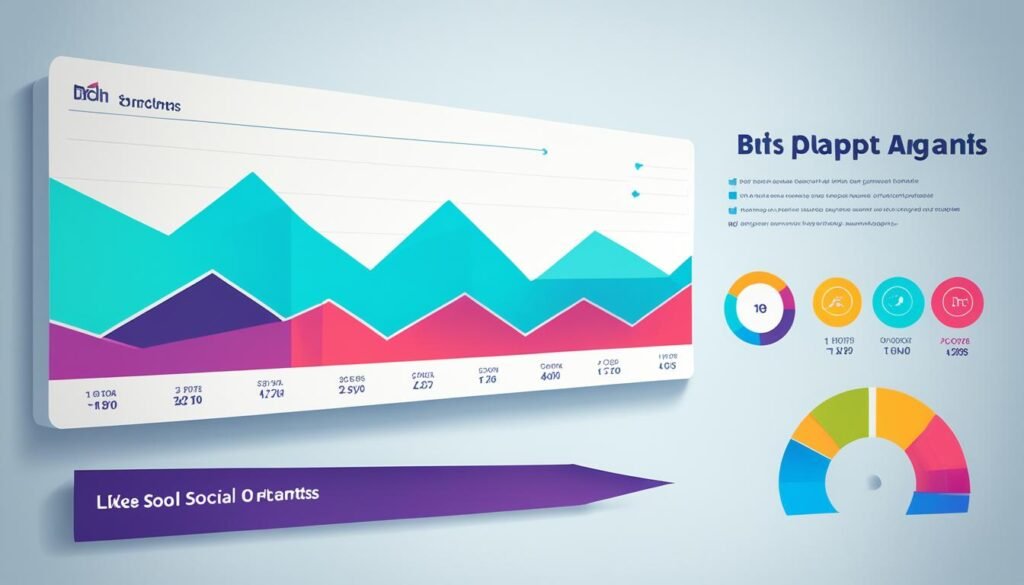In the world of social media, likes and shares have long been the gold standard for measuring success. However, it’s important to move beyond these surface-level metrics and explore the deeper impact they can have on your online presence and social media success. Understanding the role of likes and shares in social media engagement is crucial for optimizing your social media marketing efforts. In this article, we will delve into the meaning of likes and shares, their significance as key metrics, and how to effectively utilize them in your social media campaigns.
Key Takeaways:
- Likes and shares are forms of social media engagement that indicate a user’s interest and interaction with a particular post or piece of content.
- They play a crucial role in social media marketing as they contribute to the overall engagement of your audience and can have a significant impact on the success of your campaigns.
- Tracking likes and shares can help you measure the effectiveness of your social media strategies and understand the impact of your social media presence.
- While likes are a popular metric, other metrics such as the engagement rate and sentiment analysis offer a more in-depth view of how your audience is interacting with your content.
- Social media engagement, including likes and shares, has a direct impact on your online presence by increasing the visibility of your content and enhancing your overall engagement metrics.
The Meaning of Likes and Shares
Likes and shares are forms of social media engagement that indicate a user’s interest and interaction with a particular post or piece of content. Likes are often represented by icons such as a thumbs-up or a heart, while shares involve the act of reposting or forwarding the content to one’s own social media network.
These metrics provide insights into the resonance of your content and its reach within the social media landscape. Tracking likes and shares can help you measure the effectiveness of your social media strategies and understand the impact of your social media presence.
By analyzing the likes and shares on your social media posts, you can gain valuable data on the popularity and engagement level of your content. This information can be used to evaluate the success of your social media campaigns and make informed decisions about your social media strategies.
Likes and shares are not just numbers; they represent real interactions and engagement from your audience. These metrics are essential for assessing the impact of your content and determining the effectiveness of your social media efforts.
In addition to likes and shares, there are other social media metrics and analytics that can provide a more comprehensive view of your social media performance. These metrics include engagement rate, reach, impressions, and audience demographics, among others.
Engagement Rate
The engagement rate measures the level of interaction that your social media posts receive. It calculates the percentage of people who actively engage with your content by liking, sharing, commenting, or clicking on your posts. The higher the engagement rate, the more effective your social media strategy and content are at capturing and retaining audience attention.
Social Media Platforms and Metrics
Each social media platform has its own set of metrics for measuring engagement, such as Facebook likes and shares, Twitter retweets, Instagram likes and comments, and LinkedIn shares. Understanding these metrics for each platform can help you tailor your content and strategies accordingly.
Furthermore, social media analytics tools provide valuable insights into your social media performance, allowing you to track and analyze the impact of your social media presence across various platforms. These tools help you identify trends, measure the success of your social media campaigns, and make data-driven decisions to improve your social media efforts.
Utilizing Social Networks
Engagement on social media platforms goes beyond likes and shares. It involves building connections, establishing relationships, and fostering meaningful interactions. By actively engaging with your audience, responding to comments and messages, and participating in conversations, you can create a strong social media presence that enhances brand loyalty and drives further engagement.
Table: Comparison of Social Media Metrics
| Metric | Definition | Why It Matters |
|---|---|---|
| Likes | The number of times your content has been liked by users on social media. | Indicates user interest and positive feedback. |
| Shares | The number of times your content has been shared or reposted by users on social media. | Expands the reach of your content and increases brand visibility. |
| Comments | The number of comments received on your social media posts. | Shows active engagement and encourages conversations. |
| Clicks | The number of times users clicked on a link included in your social media post. | Indicates interest in your content and can drive website traffic. |
| Engagement Rate | The percentage of users who interact with your content compared to the total number of impressions. | Measures the effectiveness of your social media campaigns and content. |
Understanding the meaning of likes and shares and their significance as social media metrics allows you to gauge the effectiveness of your content and engagement strategies. By analyzing these metrics alongside other analytics, you can optimize your social media efforts and create engaging experiences for your audience.
The Role of Likes and Shares in Social Media Marketing

Likes and shares play a crucial role in social media marketing as they contribute to the overall engagement of your audience and can have a significant impact on the success of your campaigns. By increasing the number of likes and shares, you can boost your online visibility, enhance brand awareness, encourage user engagement, and drive website traffic.
Likes and shares also help in amplifying the reach of your content by enabling viral content sharing. When your audience shares your posts on their own social media profiles, it exposes your brand to a wider audience, potentially leading to more likes and shares. This can exponentially increase the visibility of your content and enhance brand awareness.
One of the primary advantages of social media marketing is the ability to directly engage with your audience. Likes and shares are indicators of the level of interest and interaction your posts generate. By improving the quality of your content to encourage likes and shares, you can increase social engagement and establish a stronger connection with your target audience.
Furthermore, likes and shares enhance your credibility and demonstrate social proof. When users see that your posts have numerous likes and shares, it creates a sense of trust in your brand and the content you produce. This, in turn, can improve your likes on posts and encourage more shares, leading to a cycle of increasing engagement and reputation for your brand.
“Likes and shares are the currency of social media. The more likes and shares your content receives, the more it resonates with your audience, and the stronger your social media presence becomes.” – Social Media Expert
Enhancing Brand Awareness and Increasing Online Visibility
By optimizing your social media strategy to improve likes and shares, you can significantly enhance your brand awareness. When your content is shared by your audience, it reaches a wider network of individuals who may not have been familiar with your brand initially. This expanded reach can introduce new potential customers to your brand, increasing the chances of gaining new followers and customers.
In addition, an increase in likes and shares can boost your online visibility. Social media algorithms often prioritize popular posts with high engagement, making them more likely to appear in users’ feeds. As a result, your content will have a higher chance of being seen by a larger audience, further increasing your brand’s online visibility.
Driving Website Traffic and Boosting Social Engagement
By effectively leveraging likes and shares, you can drive more traffic to your website. When your followers engage with your content through likes and shares, they may be more inclined to visit your website to learn more about your brand or explore the products and services you offer.
Moreover, increased likes and shares can lead to higher levels of social engagement. As more individuals interact with your content and share it with their own networks, it creates a ripple effect, generating more likes and shares. This continuous cycle of engagement can help you build a community of loyal followers who actively participate in your brand’s social media activities.
Strategies to Increase Likes and Shares on Social Media
| Strategy | Description |
|---|---|
| Create Compelling Content | Develop high-quality content that resonates with your target audience and prompts them to like and share. |
| Utilize Visuals | Incorporate visually appealing images, videos, and infographics to capture attention and encourage sharing. |
| Engage with Your Audience | Respond to comments, engage in conversations, and interact with your audience to foster a sense of community and encourage sharing. |
| Incentivize Sharing | Offer incentives, such as discounts or exclusive content, to encourage users to share your posts with their networks. |
| Collaborate with Influencers | Partner with influencers in your industry to amplify your reach and tap into their engaged audience. |
By implementing these strategies, you can improve likes on posts and get more shares, ultimately increasing your website shares and overall social media engagement. Remember, understanding how to effectively leverage likes and shares is key to achieving social media marketing success.
Beyond Likes: Meaningful Engagement Metrics

While likes are a popular metric, they represent only surface-level interaction and may not provide a comprehensive understanding of engagement. Other metrics, such as the engagement rate, sentiment analysis, reach and impressions, and conversion rate, offer a more in-depth view of how your audience is interacting with your content.
These metrics go beyond likes and provide valuable insights into the effectiveness of your social media strategies, the sentiment surrounding your brand, and the actual impact of your social media presence. By tracking these metrics, you can measure the success of your social media campaigns and optimize your efforts for greater results.
For example, the engagement rate measures the level of interaction your audience has with your posts, taking into account likes, shares, comments, and other forms of engagement. It provides a more accurate reflection of your content’s resonance with your audience.
Sentiment analysis allows you to gauge the emotional response of your audience towards your brand or specific content. It helps you understand how your target audience perceives your brand and enables you to tailor your messaging accordingly.
Reach and impressions provide insights into the number of people exposed to your content and the frequency at which it is viewed. By monitoring these metrics, you can assess the visibility and potential impact of your social media efforts.
The conversion rate measures the percentage of your audience who take a desired action, such as making a purchase or signing up for a newsletter, based on engaging with your social media content. It helps evaluate the effectiveness of your social media strategies in driving tangible results.
These meaningful engagement metrics go beyond the mere counting of likes and shares, offering a deeper analysis of your brand on social media and the effectiveness of your social media presence. By focusing on these metrics and leveraging them to inform your strategies, you can build a strong social media presence and drive meaningful engagement with your audience.
The Impact of Social Media Engagement on Your Online Presence

Social media engagement plays a crucial role in shaping and enhancing your online presence. By harnessing the power of social media platforms, you have the opportunity to amplify the impact of your online interactions and extend the visibility of your content.
Increased likes and shares on social media are key indicators of audience interest and interaction. When users engage with your content by liking, commenting, and sharing, it signifies a higher level of engagement and contributes to the overall visibility of your brand.
By actively encouraging social media interaction and striving to boost likes and shares, you can improve the metrics that determine your online visibility and reach. The more likes and shares your content receives, the greater the potential for your message to be seen by a wider audience.
Enhancing your online presence through social media engagement also goes beyond mere visibility. It creates opportunities for meaningful interactions with your audience, fostering a sense of community and trust. When users engage with your content through likes and shares, they are not only expanding its reach but also endorsing it to their own network.
Utilizing social media analytics and tracking tools can provide valuable insights into the impact of your social media engagement. By monitoring metrics such as likes, shares, and engagement rates, you can gauge the effectiveness of your social media efforts and make data-driven decisions to improve your online presence.
Ultimately, harnessing the power of social media engagement, boosting likes and shares, and improving engagement metrics can significantly increase your online visibility and enhance your overall online presence. By actively engaging with your audience and consistently providing valuable content, you can establish a strong social media presence and expand your reach in the digital landscape.
Through strategic social media interaction, you have the power to amplify your online presence and make a lasting impact in the digital realm.
Measuring and Analyzing Likes and Shares

When it comes to social media analytics, measuring the effectiveness of your social media efforts is crucial. To get a holistic view of your social media presence and make data-driven decisions, it’s important to track key metrics that matter, including likes and shares. By utilizing social media analytics tools, you can measure the number of likes, track the frequency of shares, and analyze the overall engagement of your audience.
Counting likes and shares provides valuable insights into the impact of your social media strategies. It allows you to understand the level of engagement your content is generating, as well as the reach and resonance it has within your audience. By measuring these metrics, you can identify patterns and trends, identify posts that are receiving many likes, comments, or shares, and optimize your strategies accordingly.
“Likes and shares are not just surface-level metrics; they carry valuable information about your social media success.”
For example, tracking likes and shares on platforms like Facebook can give you a deeper understanding of how your content is performing and resonating with your audience. By analyzing these metrics, you can identify the types of posts that receive the most engagement and replicate their success in future campaigns.
By having a strong social media presence and measuring likes and shares, you can gain a clear picture of the effectiveness of your social media efforts. This data-driven approach allows you to identify which strategies are working and which need adjustments. It also helps you identify opportunities for growth and improvement.
Remember, measuring likes and shares is just one part of the equation. It’s important to take a holistic view of your social media analytics, considering other metrics such as reach and impressions, engagement rate, and sentiment analysis. By looking at the bigger picture, you can gain valuable insights into the effectiveness of your social media strategies and make informed decisions to drive even stronger engagement and achieve your social media goals.
The Impact of Measuring Likes and Shares
Measuring likes and shares not only helps you understand the effectiveness of your social media efforts but also provides actionable insights to improve your social media strategy. By analyzing these metrics, you can:
- Identify the type of content that resonates the most with your audience, allowing you to create more engaging posts.
- Improve your brand’s visibility by focusing on creating content that generates high engagement and encourages sharing.
- Track the progress of your social media campaigns and make data-driven decisions to optimize your strategies.
- Identify potential influencers or brand advocates based on the engagement they generate.
The key is to focus on the metrics that matter and align them with your social media goals. By consistently tracking and analyzing likes and shares, you can continuously improve your social media presence and drive stronger engagement.
Utilizing Likes and Shares in Your Content Strategy

Likes and shares play a crucial role in optimizing your social media posts for higher engagement and achieving successful social media campaigns. When developing your content strategy, it is important to consider these social media engagement metrics to maximize the effectiveness of your efforts.
Understanding the type of content that resonates with your audience is key to optimizing your social media presence. By analyzing the likes and shares received on different types of content, you can gain valuable insights into what your audience finds most interesting and engaging.
Moving beyond surface-level metrics like likes and shares allows you to create more impactful content strategies. While likes and shares provide an initial indication of engagement, it is important to delve deeper and analyze other metrics such as comments, click-through rates, and conversion rates to truly measure the success of your social media efforts.
By leveraging social media engagement metrics, you can tailor your content strategy to drive higher engagement and achieve higher conversion rates. This may involve creating more interactive content, incorporating user-generated content, or experimenting with different formats such as videos, infographics, or podcasts.
When utilizing likes and shares in your content strategy, it is essential to move beyond the surface-level metrics and focus on creating content that resonates with your audience. By consistently delivering valuable and relevant content, you can foster a strong social media presence, enhance brand awareness, and ultimately drive higher engagement.
Example Content Strategy Framework:
Below is a framework to help you optimize your content strategy by leveraging likes and shares:
| Step | Actions |
|---|---|
| 1 | Conduct audience research to understand their interests and preferences. |
| 2 | Analyze the likes and shares received on your past social media posts to identify themes and patterns. |
| 3 | Develop a content calendar that includes different types of content (e.g., articles, videos, infographics) based on your audience’s preferences. |
| 4 | Monitor the performance of your social media posts by tracking likes, shares, comments, and other engagement metrics. |
| 5 | Optimize your content strategy based on the insights gained from analyzing the likes and shares, experimenting with new content formats, and adjusting your messaging. |
By following this framework and leveraging likes and shares, you can create a more targeted and effective content strategy that drives higher engagement and delivers meaningful results on social media.
Increasing Likes and Shares on Social Media

Increasing likes and shares on social media requires a strategic approach. To increase likes and boost shares, it is essential to create viral content and shareable posts that resonate with your audience. By delivering valuable and engaging content, you can encourage social media interaction and drive shares.
A key aspect of increasing likes and shares is focusing on content popularity. By creating content that captures the attention and interest of your target audience, you can incentivize them to share it with their own networks. This not only increases your reach but also enhances your online presence and brand visibility.
One effective strategy for driving shares is to create shareable posts that trigger emotional responses or provide practical value to your audience. For example, crafting content that evokes laughter, awe, or curiosity can encourage sharing among social media users. Additionally, providing helpful tips, insightful information, or exclusive offers can motivate users to share the content to benefit others.
When creating shareable posts, it is crucial to consider the user engagement on social platforms. Tailor your content to the specific social media platform you are using, considering factors such as the format, style, and preferences of the platform’s user base. By aligning your content with the platform’s culture and trends, you can increase its likelihood of being shared.
“Creating shareable posts that evoke emotions or provide practical value can significantly increase the likelihood of your content being shared on social media.”
In addition to creating shareable content, it is important to actively drive shares through strategic promotion. Encourage your audience to share your content by including clear calls-to-action, such as “Tag a friend who would love this!” or “Share this post with your network.” Additionally, consider collaborating with influencers or partners who have a strong online presence to amplify your reach and encourage sharing.
Lastly, to foster a culture of sharing, it is essential to engage with your audience and encourage their participation. Respond to comments, ask questions, and invite users to share their thoughts and experiences. By fostering a sense of community and connection, you can create more opportunities for your content to be shared.
Summary Table: Strategies to Increase Likes and Shares
| Strategies | Description |
|---|---|
| Create Shareable Content | Develop content that resonates with your audience and triggers emotional responses or provides practical value, making it more likely to be shared. |
| Focus on Content Popularity | Create content that captures the attention and interest of your audience to incentivize likes and shares, enhancing your online presence and brand visibility. |
| Consider User Engagement on Social Platforms | Align your content with the platform’s culture and trends, tailoring it to the format, style, and preferences of the platform’s user base. |
| Drive Shares through Strategic Promotion | Include clear calls-to-action and collaborate with influencers or partners to amplify reach and encourage sharing. |
| Encourage Audience Participation | Engage with your audience, respond to comments, and invite users to share their thoughts and experiences to foster a culture of sharing. |
Measuring the Impact of Likes and Shares on Engagement and Sales

Likes and shares on social media are valuable indicators of engagement, but to truly understand their effectiveness, it’s important to measure their impact on essential outcomes like conversions and sales. By analyzing the relationship between likes, shares, and conversion metrics, you can gain valuable insights into the effectiveness of your social media strategies in driving engagement and generating sales.
While likes and shares are important metrics, they represent surface-level engagement. To measure the true impact of your social media efforts, it’s essential to move beyond these metrics and focus on the ones that truly matter.
Conversion Rate: The Metric That Matters
The conversion rate is a key metric that goes beyond likes and shares to measure the effectiveness of your social media strategies in driving actual sales or desired actions. It calculates the percentage of users who take a specific action, such as making a purchase, signing up for a newsletter, or downloading a resource, after engaging with your social media content.
By tracking the conversion rate, you can identify the effectiveness of your social media campaigns in driving user actions and adjust your strategies accordingly to improve engagement metrics and increase sales.
Understanding Social Media Metrics to Improve Engagement
While likes and shares are important indicators of engagement, they should be measured alongside other relevant metrics to gain a comprehensive understanding of your social media performance. Some key metrics to consider include:
- Engagement Rate: Measure the overall level of interaction and interest from your audience by tracking the ratio of likes, shares, and comments to the number of followers or impressions.
- Reach and Impressions: Assess the visibility of your content by analyzing the number of times your posts appear on users’ feeds (reach) and the total number of views (impressions).
- Conversion Rate: Measure the percentage of users who take a specific desired action after engaging with your social media content, such as making a purchase, filling out a form, or subscribing to a service.
By analyzing these metrics, you can gain deeper insights into the effectiveness of your social media strategies, improve engagement metrics, and drive conversions and sales.
It’s crucial to move beyond surface-level engagement metrics like likes and shares to focus on the ones that truly matter. By analyzing conversion rates and other relevant metrics, you can measure the impact of likes and shares on engagement and sales, and refine your social media strategies for greater success.
| Metric | Description |
|---|---|
| Engagement Rate | The ratio of likes, shares, and comments to the number of followers or impressions, measuring overall audience interaction and interest. |
| Reach and Impressions | The visibility of your content, tracking the number of times your posts appear on users’ feeds (reach) and the total number of views (impressions). |
| Conversion Rate | The percentage of users who take a specific desired action after engaging with your social media content, such as making a purchase or signing up for a newsletter. |
By evaluating these metrics and their impact on engagement and sales, you can make data-driven decisions, improve your social media strategies, and achieve greater success in driving results through your social media efforts.
Also Read: Understanding Essential Social Media Terms Explained
Conclusion
Likes and shares play a significant role in social media engagement, but it is essential to recognize their place in the larger context. By exploring how social media metrics go beyond likes and shares, you can gain a deeper understanding of the impact of your social media strategies. Metrics such as engagement rate, visibility of your posts, and reach and impressions provide valuable insights into the overall measure of engagement on social media platforms.
Engagement rate signifies the level of interaction with your content, while reach and impressions provide insights into how many times your content has been seen. By focusing on these metrics and understanding their significance, you can optimize your social media strategies to enhance the visibility of your posts and drive greater engagement.
Measuring the effectiveness of your social media efforts goes beyond the number of likes and shares. It involves tracking the engagement rate, reach, and impressions to get a holistic view of your content’s performance. By leveraging these metrics, you can improve your social media strategies and achieve greater success in building your online presence and driving engagement with your audience.
FAQs
Q: What are likes and shares on social media?
A: Likes and shares on social media refer to the interactions users have with content posted on various social media platforms. Likes indicate that a user appreciates or supports a post, while shares mean the user re-posts the content for their own followers to see.
Q: How can I get more likes on social media?
A: To increase the number of likes on your posts, you can try posting engaging content, using eye-catching visuals, interacting with your audience, running contests, and collaborating with influencers.
Q: Why is sentiment analysis important in social media?
A: Sentiment analysis allows businesses to understand how audiences feel about their brand, products, or services. This insight helps in shaping marketing strategies, improving customer relationships, and managing online reputation.
Q: What metrics should I track for social media success?
A: Key metrics to track for social media success include engagement rates, reach and impressions, conversion rates, follower growth, click-through rates, and sentiment analysis.
Q: How can I go beyond likes and shares on social media?
A: To go beyond likes and shares, focus on building relationships with your audience, providing valuable content, encouraging discussions, and measuring deeper engagement metrics like comments, shares, and click-through rates.
Q: Why is engagement key in the realm of social media?
A: Engagement is key in social media because it shows how actively your audience is interacting with your content. High engagement rates indicate that your content is resonating with users, leading to increased visibility and brand loyalty.
Q: How can I effectively use different social media platforms?
A: To effectively use different social media platforms, tailor your content to fit each platform’s unique audience and posting style, use hashtags strategically, engage with followers, track key metrics, and stay updated on trending topics.
Source Links
- https://theacademicdesigner.com/2021/what-is-social-media-engagement/
- https://dashthis.com/kpi-examples/social-likes/
- https://socialjackmedia.com/beyond-likes-and-shares-understanding-social-media-metrics/





